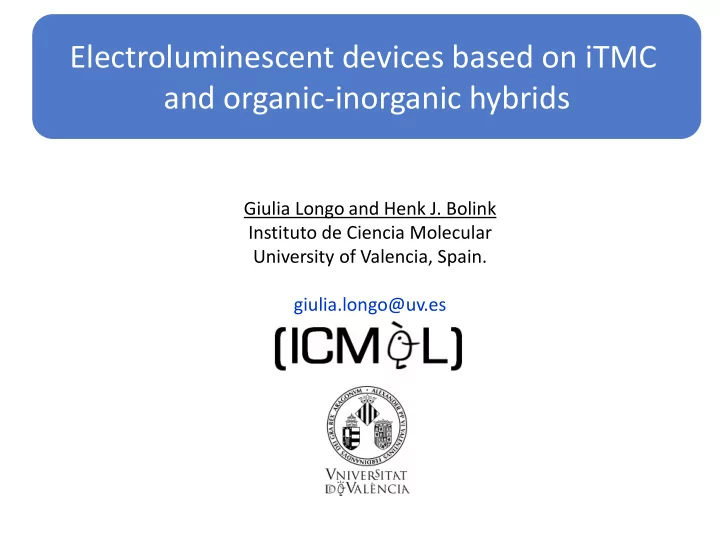

Electroluminescent devices based on iTMC and organic-inorganic hybrids Giulia Longo and Henk J. Bolink Instituto de Ciencia Molecular University of Valencia, Spain. giulia.longo@uv.es
Background - Bachelor degree in Industrial Chemistry, University of Padua, Italy - Master degree in Industrial Chemistry, University of Padua, Italy
Main objectives • Ionic transition metal complexes evaluation through preparation of light emitting devices • Design of new hybrid emitting material and its optimization for devices applications
Light emitting devices: LECs
Light emitting devices: OLED vs LEC Reactive material: Air stable metal INCAPSULATION Vacuum evaporation Spin coating
Ionic transition metal complexes based LECs Light Emitting Layer consists of: Ionic transition-metal complex (iTMCs) (and ionic liquids) Poly(3,4-ethylenedioxythiophene):polystyrensulfonate K. M. Maness et al. J. Am. Chem. Soc. 1996 , 118 , 10609. A. Wu et al. J. Am. Chem. Soc. 1999 , 121 , 4883. E. S. Handy et al. J. Am. Chem. Soc. 1999 , 121 , 3525. Review: Costa, et al. Angew. Chem. Int. Ed. 2012 , 51 , 8178.
Mechanism of work a) Electrodinamical b) Electrochemical doping doping Cations form electric double The movement of the ions layer: drop of electric leads to the formation of p- potential at the electrodes and n-doped region; the interfaces. emission take place in the Cations are joined in the intrinsic region, where there is bulk, and there is emission a drop in the potential, that only in the field free region favors the light emission. Both can occur, depending on charge injection : if we have good charge injection the electrochemical model takes place, if the injection is bad the device works under electrodynamic conditions R. D. Costa, E. Ortí , H. J. Bolink, F. Monti, G. Accorsi and N. Armaroli, Angewandte Chemie International Edition , 2012, 51 , 8178-8211.
Material characterization: typical curves and figures of merit Efficacy Emitted light per electric flux (Cd/A) GLASS/ITO/Pedot/JF317:IL 4:1/Al 600 10 Luminance 9 500 Flux of light emitted by the device (cd/m 2 ) 8 2 ] Luminance [cd/m 400 Voltage [V] 7 300 6 Turn on time: Time to reach 100 cd/m 2 5 200 Time to reach the máximum luminance 4 100 3 Lifetime 0 2 Time to reach half of the maximum luminance 0 20 40 60 80 Time [h]
Cu I complexes evaluation Chemical modifications of Cu I based iTMC and their performances in LECs Collaboration with professor C. Housecroft, University of Basel S. Keller et. al., [Cu(bpy)(P^P)]+ containing LECs: improving performance through simple substitution, submitted
Organic-inorganic materials: Pb 2+ based perovskites
Organic-inorganic hybrid materials: perovskite A: organic cation B: Inorganic cation O: X - + A: bigger than CH 3 NH 3 layered structure + A: CH 3 NH 3 Cubic structure
Quantum well structure Conduction band Valence band Different organic cations or halides permits to modulate the band gap of the inorganic part D. B. Mitzi, Journal of Materials Chemistry , 2004, 14 , 2355-2365.
CH 3 NH 3 PbI 3 King of the solar cells: up to 19% of efficiency in three years! 3.8 eV 1.61 eV 770 nm 5.4 eV G. Longo et al, Efficient photovoltaic and electroluminescent perovskite devices, JACS, submitted K. Tvingstedt, O. Malinkiewicz, A. Baumann, C. Deibel, H. J. Snaith, V. Dyakonov and H. J. Bolink, Sci. Rep. , 2014, 4 .
From infrared to visible emission CH 3 NH 3 PbBr 3 CH 3 NH 3 PbI 3 3.6 eV 3.7 eV 2.3 eV I - Br - 1.6 eV 539 nm 770 nm 5.4 eV 5.9 eV 3 160 140 120 2 100 Absorbance 80 Intensity 60 1 40 20 0 0 -20 500 600 700 800 900 400 500 600 700 Wavelength (nm) Wavelenght
OLED with perovskite active layer Structure: -2.3 -2.75 ITO Ba/Ag -3.0 -3.6 PEDOT:PSS PEDOT:PSS CH 3 NH 3 PbBr 3 CH 3 NH 3 PbBr 3 TPBi ITO TPBi -4.7 Ba/Ag -5.2 -5.9 -6.2
Perovskite performances 10 100 CURRENT DENSITY (A/m^2) High leakage current. 1 Usually around 1E-5 and1E-6 LUMINANCE (Cd/m^2) 10 Due to defect on the layer 0.1 1 0.01 0.1 1E-3 0.01 -1 0 1 2 3 4 VOLTAGE (V) Very low luminescence at 4V!!
Difficulties in perovskite - Very new material: poorly characterized, especially MAPbBr - Limited solvent for solution process: DMF, DMSO - Difficulties in finding orthogonal solvent - Extremely sensitive to water: glovebox - Content of lead
Possible solutions and further attempts - Different blocking-transport material that can be dissolved in good solvents - Inverted structures - Different organic cation in the perovskite structure - Different stoichiometric ratio between the perovskite components - Disperd the perovskite material on a porous media (Al 2 O 3 , ZnO, TiO 2 …) - Evaporation of perovskite and/or other layers - Use nanoparticles instead of bulk material - Intercalate in the perovskite structure an organic sensitizer or emitter
Thank you for your attention!
Light emitting diodes with perovskites First reports on perovskite light emission: Very low temperature Era, m. et al, Apl. Phys. Lett ., 1994 ,65,676 Room temperature with incorporated organic emitter Chondroudis et al, Chem. Mater ., 1999 , 11, 3028 All have used layered structure
Recommend
More recommend